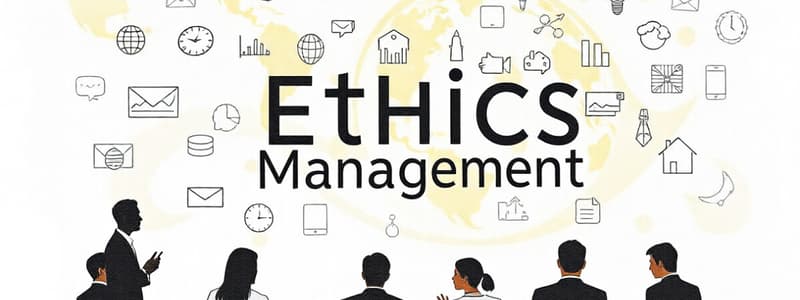Podcast
Questions and Answers
Within the context of ethical decision-making, which rule is focused on creating the greatest benefit for the largest number of individuals?
Within the context of ethical decision-making, which rule is focused on creating the greatest benefit for the largest number of individuals?
- Justice Rule
- Moral Rights Rule
- Utilitarian Rule (correct)
- Practical Rule
Stockholders primarily want to minimize their return on investment and ensure managers behave ethically.
Stockholders primarily want to minimize their return on investment and ensure managers behave ethically.
False (B)
What is an 'ethical dilemma'?
What is an 'ethical dilemma'?
A situation where an individual must decide whether to act in a way that benefits another party, even if it conflicts with their own self-interest.
Companies can behave ethically toward employees by creating an _________ that fairly and equitably rewards them for their contributions.
Companies can behave ethically toward employees by creating an _________ that fairly and equitably rewards them for their contributions.
Match the stakeholder group with their primary expectation:
Match the stakeholder group with their primary expectation:
What's the accurate metaphor describing the invisible obstacles hindering minorities and women from advancing to executive leadership positions in organizations?
What's the accurate metaphor describing the invisible obstacles hindering minorities and women from advancing to executive leadership positions in organizations?
Effective management of diversity is solely an ethical issue, with no impact on a company's business performance.
Effective management of diversity is solely an ethical issue, with no impact on a company's business performance.
Briefly describe the role of an 'Ethics Ombudsman'.
Briefly describe the role of an 'Ethics Ombudsman'.
Within the context of workforce diversity, __________ involves grouping people based on shared attributes like national origin.
Within the context of workforce diversity, __________ involves grouping people based on shared attributes like national origin.
Which action is most indicative of a manager fostering accommodation of religious beliefs in the workplace?
Which action is most indicative of a manager fostering accommodation of religious beliefs in the workplace?
Flashcards
Ethical dilemma
Ethical dilemma
A situation where people must decide whether to act in a way that helps someone else, even if it goes against their self-interest.
Ethics
Ethics
The moral principles, values, and beliefs that guide people in analyzing situations and deciding on appropriate behavior.
Stakeholders
Stakeholders
Individuals and groups that provide a company with necessary resources, thus having a claim and stake in the company.
Utilitarian Rule
Utilitarian Rule
Signup and view all the flashcards
Diversity
Diversity
Signup and view all the flashcards
Trust
Trust
Signup and view all the flashcards
Glass Ceiling
Glass Ceiling
Signup and view all the flashcards
Reputation
Reputation
Signup and view all the flashcards
Quid Pro Quo Harassment
Quid Pro Quo Harassment
Signup and view all the flashcards
Hostile Work Environment
Hostile Work Environment
Signup and view all the flashcards
Study Notes
Managing Ethics and Diversity
- Illustrate how ethics help managers determine the right way to behave when dealing with different stakeholder groups
- Explain why managers should behave ethically and strive to create ethical organizational cultures
- Appreciate the increasing diversity of the workforce and the organizational environment
- Grasp the central role that managers play in the effective management of diversity
- Understand why the effective management of diversity is both an ethical and a business imperative
- Understand the two major forms of sexual harassment and how they can be eliminated
The Nature of Ethics
- Ethical Dilemma: A quandary in which people decide whether to act in a way that helps another person or group, even if it goes against their self-interest
- Ethics: The inner-guiding moral principles, values, and beliefs used to analyze a situation and decide the appropriate way to behave
Stakeholders and Ethics
- Stakeholders: People and groups that supply a company with its productive resources, having a claim and stake in the company
Types of Company Stakeholders
- Stockholders want to ensure managers behave ethically and don't risk investors' capital through actions damaging the company's reputation
- Stockholders also aim to maximize their return on investment
- Managers use a company's financial capital and human resources to increase performance and stock price
- Right to expect a good return or reward by investing their human capital to improve a company's performance.
- Employees: Companies can act ethically toward employees by creating an occupational structure that fairly and equitably rewards employees for their contributions
- Suppliers expect to be paid fairly and promptly for their inputs
- Distributors expect to receive quality products at agreed-upon prices
- Customers, as the most critical stakeholder, require companies to increase efficiency and effectiveness to build loyalty and attract new customers
- Community: Physical locations in which companies are located
- Includes towns or cities, or social milieus, and ethnic neighborhoods
- Community provides a company with the physical and social infrastructure that allows it to operate
Four Ethical Rules
- Utilitarian Rule: An ethical decision should produce the greatest good for the greatest number of people
- Moral Rights Rule: An ethical decision should maintain and protect the fundamental rights and privileges of people
- Justice Rule: An ethical decision should distribute benefits and harm among people in a fair, equitable, and impartial manner
- Practical Rule: An ethical decision should be one that a manager has no hesitation about communicating to people outside the company because the typical person in a society would think the decision is acceptable
Practial Decision Model
- Does my decision fall within the acceptable standards that apply in business today?
- Am I willing to see the decision communicated to all people and groups affected by it?
- Would the people with whom I have a significant personal relationship approve of the decision?
Why Should Managers Behave Ethically?
- Relentless pursuit of self-interest can lead to a collective disaster if it leads to unethical behavior, encouraging others to act similarly
- Trust: Willingness of one person or group to have faith or confidence in another person's goodwill, even though this puts them at risk
- Reputation: Esteem or high repute that individuals or organizations gain when they behave ethically
Sources of an Organization's Code of Ethics
- Societal ethics: The values and standards embodied in a society's laws, customs, practices, and norms and values
- Professional ethics: The values and standards that groups of managers and workers use to decide how to behave appropriately
- Individual ethics: Personal values and standards resulting from the influence of family, peers, upbringing, and involvement in significant social institutions
Ethical Organizational Cultures
- Managers can ensure important ethical values and norms are a central component of an organization's culture
- Managers become ethical role models whose behavior is scrutinized by their subordinates
- Ethics Ombudsman: An ethics officer who monitors an organization's practices and procedures to be sure they are ethical
The Increasing Diversity of the Workforce and the Environment
- Diversity: Differences among people due to age, gender, race, ethnicity, religion, sexual orientation, socioeconomic background, education, experience, physical appearance, capabilities, disabilities, and any other characteristic used to distinguish people
Diversity Concerns
- There is an ethical imperative for equal opportunity
- Effectively managing diversity can improve organizational effectiveness
- Diverse individuals continue to experience unfair treatment in the workplace due to biases, stereotypes, and overt discrimination
- Glass Ceiling: Refers to the invisible barrier that prevents minorities and women from being promoted to top corporate positions
Workforce Diversity
- Aging U.S. Population:
- The median age is 37.8
- By 2030, 20% of the population will be over 65
- Federal Age Discrimination Laws:
- 1964 Title VII of the Civil Rights Act of 1964
- 1967 Age Discrimination in Employment Act
- Gender:
- U.S. workforce is 44.3% female
- Women's weekly median earnings are $726 compared to $895 for men
- Women hold only 14.6% of executive officer positions in the 500 largest U.S. companies
- Ethnicity:
- Grouping of people based on some shared characteristic such as national origin
- Ethnic Demographics of United States:
- 72.4% white
- 16.3% Latino
- 12.6% African American
- 4.8% Asian
- Religion:
- Accommodation for Religious Beliefs:
- Scheduling of critical meetings
- Providing flexible time off for holy days
- Posting holy days for different religions on the company calendar
- Accommodation for Religious Beliefs:
- Capabilities and Disabilities:
- Disability Issues:
- Providing reasonable accommodations for individuals with disabilities
- Promoting a nondiscriminatory workplace environment
- Educating the organization about disabilities
- Disability Issues:
- Socioeconomic Background:
- Managers need to be sensitive and responsive to the needs and concerns of workers who might not be as well off as others
- Sexual Orientation:
- Sexual Orientation Issues:
- Employment and workplace discrimination
- Provision of domestic-partner benefits
- Sexual Orientation Issues:
Critical Managerial Roles
- Managers have more influence than rank-and-file employees
- When managers commit to diversity, their authority and positions of power and status influence other members of an organization to make a similar commitment
Effectively Managing Diversity Makes Good Business Sense
- Diversity of organizational members can be a source of competitive advantage
- Recruiting diverse employees must be followed up with ongoing effective management of diversity to retain those employees
- Many organizations insist that their suppliers support diversity
- Effective management of diversity is necessary to avoid costly lawsuits
Forms of Sexual Harassment
- Quid Pro Quo: Asking for or forcing an employee to perform sexual favors in exchange for receiving some reward or avoiding negative consequences
- Hostile Work Environment: Telling lewd jokes, displaying pornography, making sexually oriented remarks about someone's personal appearance, and other sex-related actions that make the work environment unpleasant
Steps to Eradicate Sexual Harassment
- Develop and clearly communicate a sexual harassment policy endorsed by top management
- Use a fair complaint procedure to investigate charges of sexual harassment
- Take corrective action as soon as possible when sexual harassment has taken place
- Provide sexual harassment education and training to all organizational members, including managers
Studying That Suits You
Use AI to generate personalized quizzes and flashcards to suit your learning preferences.




